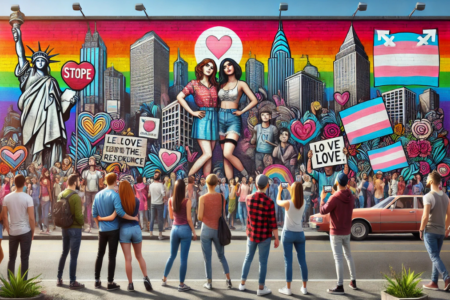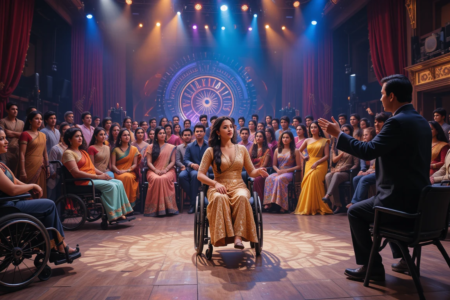The struggles of the transgender youth are not mere individual struggles, but a symbol of the collective responsibility we bear as a society. Each of these stories of hurt, rejection, and struggles to define one’s self is an image of the collective responsibility we bear as a society. The Journey toward acceptance and inclusion is not solitary. The journey toward acceptance and inclusion is not a solitary one; it requires empathy, understanding, and a commitment to change. Today, let’s delve deeper into how we can continue to uplift transgender youth and ensure they feel like they truly belong in this world. The Power of Representation: Seeing Yourself in the World Representation counts. For transgender youth, watching individuals like them in the media, in politics, in sports, and in daily life can be transformative. It’s a strong message: You are not alone. Your identity is valid. You matter. Think of being a teenager grappling with your identity, looking through social media or watching television, and never seeing anyone like you. Lack of representation may be a deafening erasure, an affirmation of the anxiety that the world doesn’t want you. But when transgender folks are honored for all their queerness—when their lives are told with candor and integrity—it makes for a ripple of hope and potential. We must insist and fashioning welcoming spaces in which transgender voices are heard. It means we must stand behind transgender artists, writers, and creators. It means we must fight for respectful and accurate representations of transgender individuals in the media. Community Support: Creating Networks of Belonging While family and school are essential pillars of support, the wider community also has a crucial role in influencing the lives of transgender youth. While family and school are essential pillars of support, the wider community also has a crucial role. But support from the community does not have to exist only in LGBTQ+ environments. Neighbors, coworkers, friends, and even strangers- all can change the world. Small and gracious acts such as respecting someone’s pronouns or challenging transphobic comments, can be deeply impactful. When we appear to or transgender children, we communicate in no uncertain terms: You are not alone. We see you and we stand with you, and we are here for you. Education and Awareness: Breaking Down Barriers Ignorance is frequently the source of prejudice. Most of the difficulties faced by transgender young people are based on a lack of Ignorance is usually the origin of prejudice. Most of the issues transgender youth face are due to a lack of knowledge about what it is to be transgender. Learning is a great tool for breaking barriers and creating empathy. Schools, workplaces, and communities need to make education on gender diversity a priority. This involves educating youth on the range of gender identities, the value of honoring pronouns, and the damage of stereotypes and discrimination. It also involves educating educators, healthcare workers, and other professionals to be knowledgeable and affirming allies. But education doesn’t end at institutions—it begins with us. Take the time to learn about transgender issues. Listen to the experiences of transgender people. Challenge your own assumptions and biases. When we educate ourselves, we become better able to create a world where everyone feels respected and valued. The Role of Faith and Spirituality: A Source of Healing, Not Harm For most families, spirituality and faith are a core part of their existence. Sadly, religious doctrine is often used to legitimize rejection or discrimination against transgender teens. However, this doesn’t have to be the way things are. Faith can also be a force for love, compassion, and healing. Faith leaders and communities have a special chance to set an example of acceptance and inclusion. By affirming the inherent value and dignity of every person, regardless of gender identity, they can send a strong message of love and belonging. Most faith traditions already affirm the values of compassion and justice—it’s time to apply those values to transgender youth. The Ripple Effect of Allyship: Small Acts, Big Impact Allyship is not an event—it’s a way of life. It’s about being present, even when it’s hard. It’s about leveraging your privilege to center marginalized voices. It’s about being willing to challenge injustice, even when it’s convenient to remain quiet. Each action of allyship, no matter how small, has the potential to bring about change. Whether it’s calling out someone who misgenders a friend, fighting for inclusive policies at work, or just listening to a transgender young person’s story, these actions accumulate. They have a ripple effect that can change lives and communities. A Call to Action: Be the Change They Need The journey to acceptance is a long one, but it’s worth taking. Every step toward justice—every bit of kindness, every attempt at listening, every challenge to discrimination—gets us one step closer to a society in which transgender kids can survive. We have to be the change they require.We have to be their supporter, their champion, their steadfast ally. We have to build a world where no transgender child ever feels isolated, where every young person is cherished for precisely who they are. This is not only about transgender youth—it’s about all of us. It’s about the world we wish to inhabit: a world in which love wins over hate, compassion conquers prejudice, and every individual has the freedom to be who they truly are. Final Thoughts: A Future of Hope and Belonging The issues transgender youth are confronting are deep, but so is the possibility of transformation. With compassion, empathy, and action, we can have a future in which every child is loved, accepted, and valued. Let’s be part of that change. Let’s hear the testimonies of transgender young people, raise their voices, and join them in their struggle for justice and equality. Let’s create a world where no one has to hide themselves, and everyone can live with dignity and pride. Together, we can transform pain into hope, loneliness into belonging, and dreams into reality. Because every child
Last week we took to the example of Ravindra Jain, the Maestro who was visually impaired and handicapped. His example can bring inspiration to many, but real problem lies in the mindset of people perceiving them as weak and needy. The underrepresentation and lack of opportunities for disabled individuals in Bollywood is a significant issue. To address this morally and ethically, the industry and society must adopt a more inclusive approach. Here are some possible solutions: Equal Chances for Everyone The film and music sectors ought to focus on employing professionals for their skills instead of their physical capabilities. Skill, imagination, and dedication are what genuinely characterize an artist, and these ought to be the main standards for choice. Regrettably, numerous talented people with disabilities face difficulties in securing jobs due to the absence of inclusive hiring practices in the industry. Casting directors, music producers, and production companies need to make concerted efforts to adopt more equitable hiring practices. A key method to guarantee equitable opportunities is by instituting quotas for disabled actors, directors, writers, and technicians. By reserving a specific percentage of positions for people with disabilities, the sector can assist in disrupting the cycle of exclusion. Nevertheless, inclusion shouldn’t merely be procedural; emotional inclusion holds equal significance. Establishing a workplace where disabled individuals feel appreciated and at ease is equally important as offering them opportunities. By promoting respectful dialogue and removing any feelings of exclusion, Bollywood should aim to build a genuinely inclusive industry. Open Infrastructure If Bollywood genuinely starts to acknowledge and welcome disabled talent, it should also create a system that facilitates their involvement in the industry. In the absence of appropriate physical arrangements, individuals with disabilities find it challenging to perform their jobs effectively and comfortably. Studios, recording booths, and film sets must have ramps, accessible seating, assistive technology, and additional essential facilities to support individuals with physical disabilities. Through these modifications, the sector will ensure that disabled workers have access, while also motivating others to step forward without worrying about logistical issues. Another important factor is transportation. Numerous disabled artists struggle to participate in auditions, shoots, and industry gatherings because of insufficient accessible transportation. The movie industry ought to offer dedicated transportation options to assist Shifting Perception In Bollywood, able-bodied actors frequently portray disabled characters. Although these performances might receive acclaim for their emotional richness, they deprive genuine disabled actors of opportunities to portray these roles with authenticity. This behavior is not just unjust but also conveys the idea that the industry lacks faith in the capabilities of disabled actors. If a character has a disability, the part should be given to someone who truly understands and faces those difficulties. In addition to casting decisions, the representation of disabled people in films needs to transform. Frequently, disabled characters are portrayed as sources of sympathy, merely grappling with their disability. This depiction reinforces stereotypes and alienates disabled people from conventional society.tion of artists, directors, and technicians with disabilities. Such funds can also be used for their training and other ancillary supports that are needed generally in the practice of making films. Rather, Bollywood ought to showcase them as competent, self-reliant persons with unique strengths, aspirations, and obstacles. Representation ought to empower rather than oppress. Movies ought to portray disabled characters as accomplished professionals, romantic interests, or even as action heroes, just like any other roles. Altering the narrative will not only foster improved opportunities for disabled performers but will also transform how viewers understand disability. Support from Financial and Institutional Sources Insufficient financial assistance is a significant barrier hindering disabled individuals from leaving their imprint in Bollywood. Numerous skilled artists, directors, and technicians with disabilities find it difficult to finance essential training, equipment, or chances to present their work. To close this gap, Bollywood ought to create specific funds and scholarships to assist aspiring professionals with disabilities. Genuine inclusivity in Bollywood necessitates a major transformation in both attitudes and frameworks. From equitable hiring practices and inclusive workplaces to proper representation and financial assistance, every facet of the industry must transform to guarantee disabled individuals obtain equal opportunities. Disability ought to be viewed not as a restriction but as an aspect of the human experience. Talent manifests in various forms, and the industry needs to acknowledge, value, and cultivate it without bias. By implementing these measures, Bollywood can serve as a model for the world, demonstrating that genuine storytelling revolves around authenticity, inclusivity, and empowerment. Change has been needed for a long time, and the moment to take action is here. Keep Reading Foramz for your daily dose of moral support.


